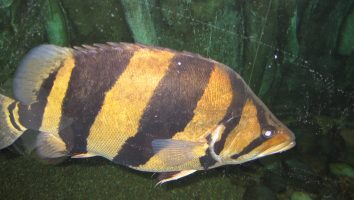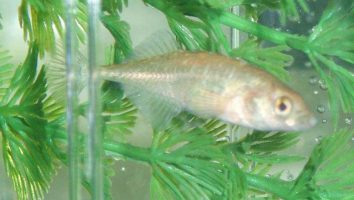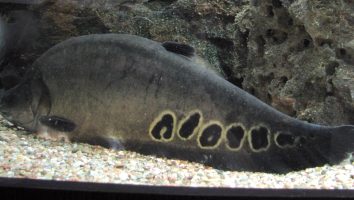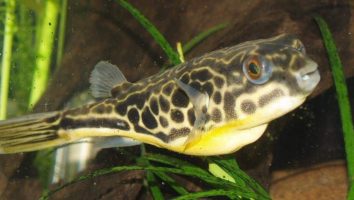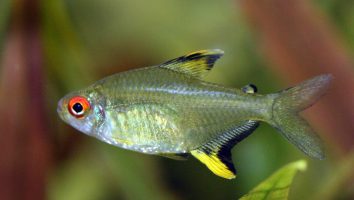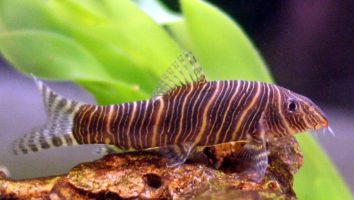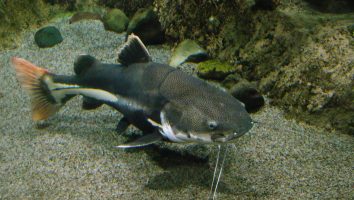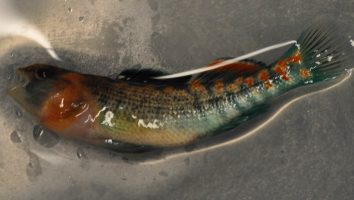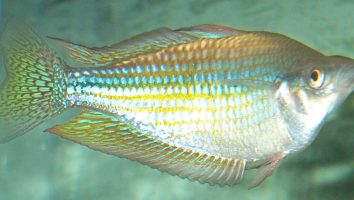The electric eel is a freshwater fish that is capable of generating electric shocks.
This fish is not for the beginner fishkeeper, and special care must be taken to ensure the electric eel’s environment is suitable.
In this guide, we will go over everything you need to know about electric eel care. We will discuss their diet, tank size, tank mates, and more!
Table of contents
Species overview
The electric eel (scientific name: Electrophorus electricus) is a type of fish that is capable of generating an electric field. It is found in the Amazon Basin in South America.
This fish has a long, cylindrical body that can grow to be over eight feet in length. The electric eel has a dark brown or black coloration with a yellow or orange belly.
The electric eel is a predatory fish that feeds on other fish, amphibians, and reptiles. It uses its electric field to stun its prey so that it can more easily catch and consume it.
The electric eel is an important part of the Amazonian ecosystem. However, it is threatened by habitat loss and pollution.
Appearance

The electric eel is an impressive creature, to say the least. These eels can grow to be over eight feet in length and weigh over forty pounds!
The vast majority of their body is taken up by their long, snake-like tail. Their head is relatively small in comparison and has a blunt nose.
They have small eyes that are set far back on their head. Behind their eyes, you’ll find a pair of feelers that they use to sense their surroundings.
The electric eel has a unique coloration that helps them to blend in with their surroundings. The top half of their body is a dark brown or black. The bottom half is a lighter brown or cream color.
The electric eel is covered in tiny scales that are very hard to see. The only time you’ll really notice them is when this fish is viewed from the side.
Lifespan
The electric eel has a lifespan of 15 years in the wild. In captivity, they can live up to 20 years.
Size
The average size of an electric eel is about 8 feet long, but they can grow to be as long as 10 feet. These eels are one of the largest freshwater fish in the world.
Tank
Tank Size
The recommended tank size for electric eels is at least 50 gallons.
A larger tank is always better, but if you must keep them in a smaller tank make sure it is at least 50 gallons.
Water Parameters
The electric eel is a fascinating fish that’s unique in more ways than one. Perhaps most notably, it’s the only known species in the knifefish family that can generate electricity.
This bony fish is native to the Amazon and Orinoco basins in South America. It’s an air-breathing fish that spends most of its time at the bottom of murky waters.
In captivity, electric eels require similar water conditions.
The most important thing to remember is that electric eels need plenty of space. They can grow to be over six feet long and need a tank that’s at least 200 gallons.
Other electric eel care requirements include:
- Water temperature: 75 to 86 degrees Fahrenheit
- pH levels: 6.5 to 7.5
- Water hardness: 2 to 12 dGH
- Alkalinity Levels: 4-8 dKH
What To Put In Their Tank
Electric eels need a lot of space to move around, so the first thing you’ll need to do is find a tank that’s big enough. A good rule of thumb is to have at least 50 gallons of water for each eel.
The next thing you need to do is set up the inside of their tank. These fish like to have plenty of places to hide, so we recommend including some driftwood, rocks, and caves.
The substrate you use is up to you, but we prefer something that’s soft and sandy. This will be more comfortable for them and it’s less likely to damage their skin.
As for plants, you can include some if you want but electric eels are known to eat them. If you do decide to go with plants we recommend something that’s tough and fast-growing (like hornwort or water wisteria).
Common Diseases
Electric eels are actually quite resilient creatures. In the wild, they can live for over 20 years!
However, that doesn’t mean that they can’t get sick. There are a few diseases that are common in electric eels, the most common being hole-in-the-head disease.
This disease is caused by poor water quality and the presence of activated carbon in your tank. It will present itself as one or two pits/holes in the skin of your electric eel’s head.
While it’s almost always curable (fixing your water quality and removing activated carbon is usually all you need to do), it will usually leave some scarring on your poor fish!
The other disease you’ll want to keep an eye out for is ich. This is obviously not an electric eel-specific illness, but since ich is so common it’s definitely worth mentioning here.
This will show itself as white spots on the body, fish, and gills of your fish. We won’t do a full ich treatment guide here (there are plenty of those online) but it’s something you need to take very seriously if it affects your electric eel.
Behavior & Temperament
The electric eel is a fascinating, if not dangerous, creature. It’s capable of delivering a 650-volt shock, which is enough to stun a human. So, it’s important to be careful when handling these fish.
In the wild, electric eels use their shock as a way to defend themselves and to capture prey. The shock stuns the fish long enough for the electric eel to grab it and eat it.
Electric eels are also known to be aggressive. In the wild, they have been known to attack humans. There have been reports of people being killed by electric eels. So, it’s important to be careful when you’re around them.
In captivity, electric eels can be a bit easier to handle. They’re not as likely to attack humans, but they can still be aggressive towards other fish. It’s important to put them in a tank by themselves to avoid any problems.
Electric eels are also known to be escape artists. They’re good at finding ways out of their tanks. So, it’s important to make sure your tank is secure.
Tank Mates
The electric eel is a fascinating fish that is best kept alone or with species of a similar size. These eels are not social creatures and do not do well with other fish.
They are, however, peaceful fish that pose no threat to their tank mates. The electric eel will not attack other fish unless they are small enough to eat.
The electric eel is a nocturnal fish that spends the majority of its time hiding in the shadows. This is another reason why they do not do well with other fish.
The electric eel needs a tank that is at least 50 gallons. A larger tank is better. These eels can grow to be over six feet in length, so they need the extra space to swim.
The electric eel is a sensitive fish that is not tolerant of poor water conditions. The tank must have a tight-fitting lid to prevent the eel from escaping. The water must be filtered and well-oxygenated.
Aquarium salt should be added to the water at a ratio of 1 tablespoon per 5 gallons.
Breeding
Electric eels are a bit different when it comes to breeding. Unlike other fish, they don’t lay eggs. Instead, the female gives birth to live young.
To breed electric eels, you’ll need to set up a tank that’s at least 200 gallons. The water should be around 75 degrees Fahrenheit with a pH of 6.5. You’ll also need to add some hiding places.
When ready, add one female and two males to the tank. The female will be larger than the males.
The female will give birth to around 20 young at a time. The gestation period is around six months.
After the young are born, you’ll need to remove the adults from the tank. The young are very delicate and need to be handled with care.
They need to be fed live food like small fish, shrimp, or worms. You can wean them onto frozen or pellets after a few weeks.
Conclusion
The electric eel is an amazing animal that is both feared and revered. They are a top predator in their environment and have few natural enemies.
While they may seem dangerous, they are actually quite docile creatures that are unlikely to hurt humans unless they are provoked.
If you are considering adding an electric eel to your home aquarium, we recommend doing your research first and making sure you are prepared to provide them with the care they need.
These fish are not for everyone, but they can make a fascinating and unique addition to your tank!

